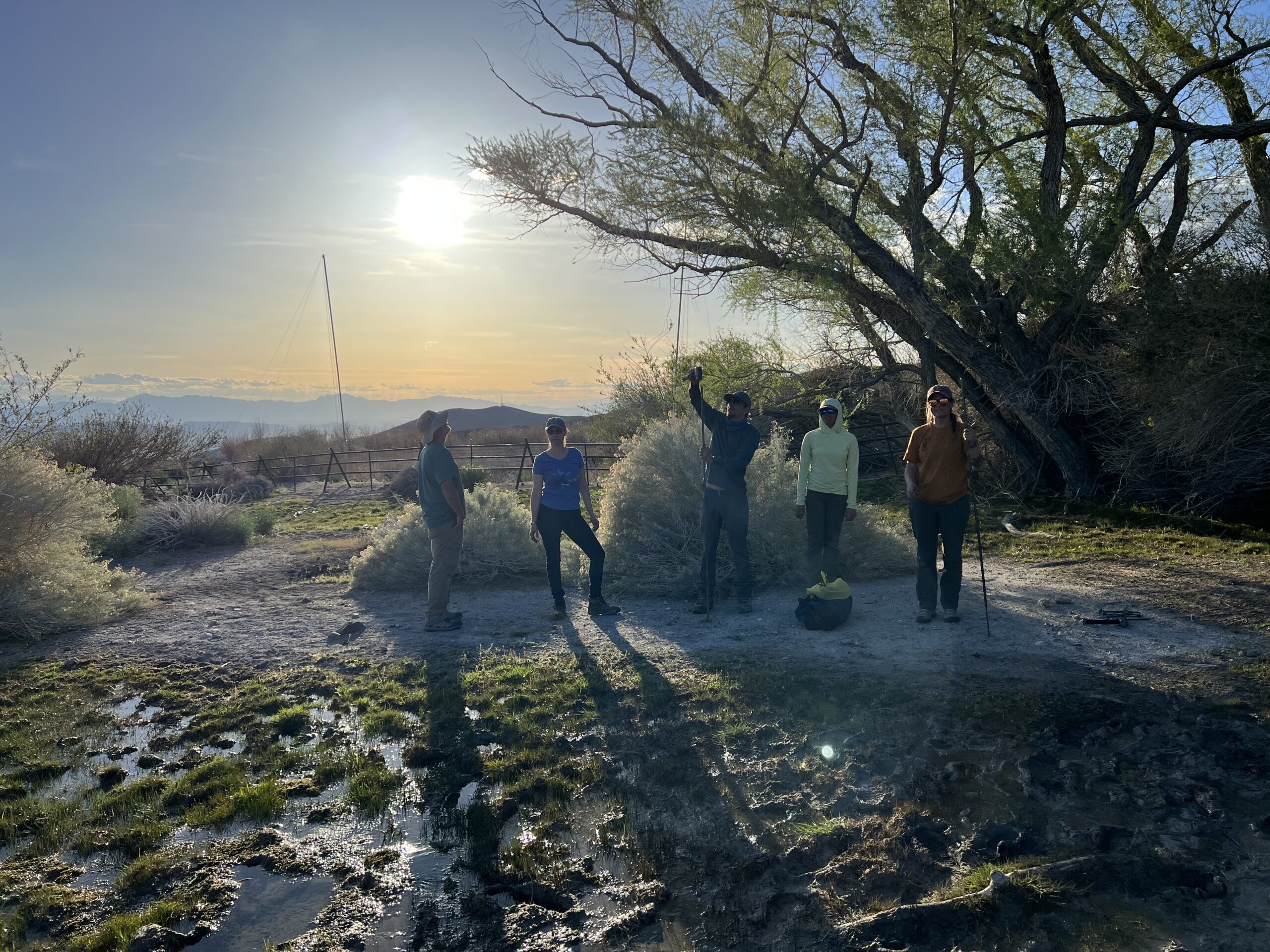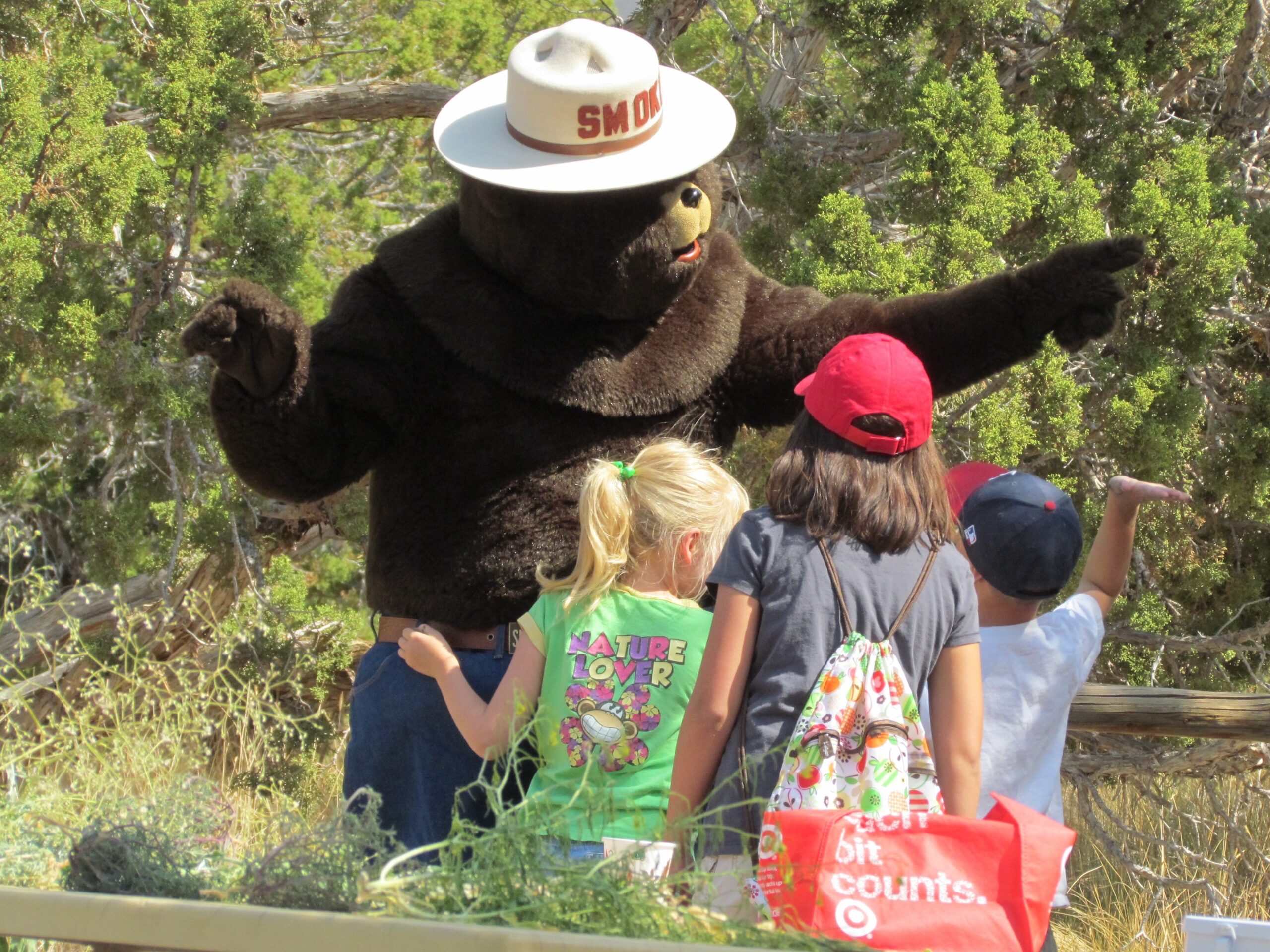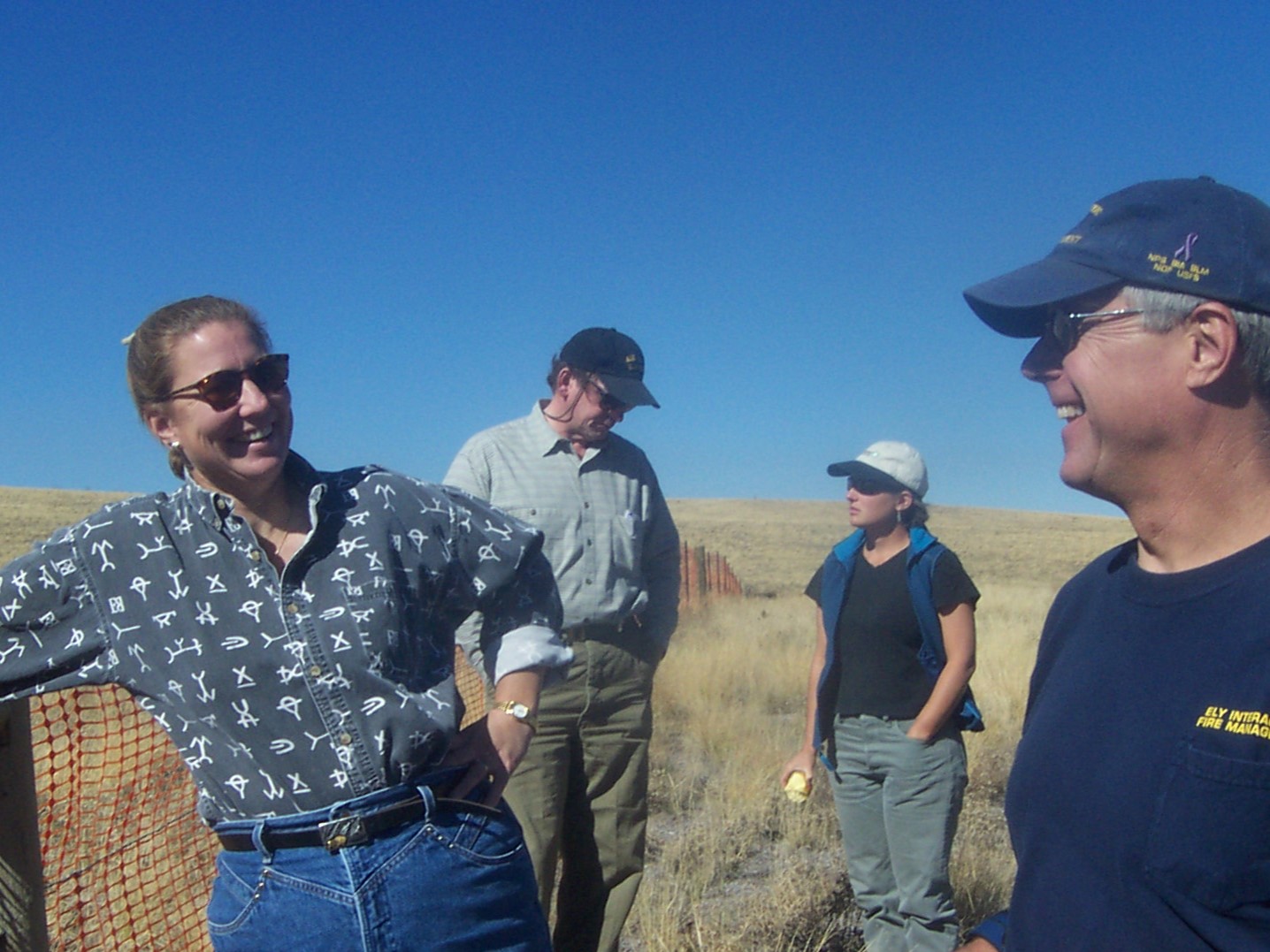ENLC’s History
2024-2023
2024
- Awarded $222,544.26 for the Intermountain West Joint Venture Landscape Restoration Project to hire a Natural Resource Specialist focusing on the restoration of aquatics and riparian areas in the Upper Humboldt and O’Neil Basins in the Elko District BLM.
- Awarded a $94,974.71 grant for the NDOW statewide small mammal survey project.
2023
- Awarded $800,937.93 for the Elko District BLM Noxious Weed Management and AIM Strategy Implementation Project.
- Awarded $577,000 for the Ely District BLM Plant Restoration and Rehabilitation Support Project.
- Awarded $135,000 for the Ely District BLM Noxious and Invasive Plant Management Project.
- Awarded $200,000 for the USFS Cooperative Agreement for the Humboldt-Toiyabe National Forest Ely Ranger District Noxious and Invasive Weeds Management and Education Project.
- Awarded $63,256 for the BLM Cooperative Agreement for the Carson City District Office Noxious and Invasive Plant Management Project.
- Awarded a $22,435.50 NDA grant for the Upper Meadow Valley CWMA, Railroad Valley CWMA and White River Valley CWMAs to continue vegetation management activities, restoration and reseeding, monitoring of post-treatment locations, and inventorying new areas.
- Awarded a $30,000 contract with NDOW for Wildlife & Habitat Enhancement Projects in Eastern and Southern Nevada.
- Awarded $206,028.64 for the BLM Cooperative Agreement for the Elko District Office Noxious and Invasive Plants Project.
- Awarded a $9,895 NDA grant for the Southern Nevada CWMA to continue vegetation management activities, restoration and reseeding, monitoring of post-treatment locations, and inventorying new areas.
2022-2021
2022
- Awarded $401,247.76 for the BLM Cooperative Agreement for the Basin and Range National Monument Acoustic Bat Inventory.
- Awarded a $154,825 US Forest Service Cooperative Agreement for a RAC Pinyon Juniper Post-Treatment Ecological Monitoring Project.
- Awarded $150,000 for the BLM Cooperative Agreement for the Ely District Fire Rehabilitation Project.
- Awarded $80,000 for the BLM Cooperative Agreement for the Carson City District Office Noxious and Invasive Plants Project.
2021
- ENLC turned 20 years old on May 15, 2021.
- Awarded a $18,663 NDA Cooperative Agreement for CWMAs.
- Awarded an $80,000 BLM Cooperative Agreement for the Carson City Invasive and Noxious Plan Management Project
2020-2018
2020
- Awarded $183,000 SNPLMA US Forest Service Grant for the Multi-Jurisdictional Weed Education project within the Eastern Nevada Landscape Restoration Project.
- Awarded $18,663 for the Nevada Department of Agriculture Grant for the Newark/Long Valley CWMA.
- Awarded a $210,525 Bureau of Land Management Contract for the Seeds of Success national native seed collection program.
- Awarded a $45,000 BLM Grant for the BARNM Botanical Inventory and Monitoring Project.
- Awarded a $150,000 BLM Cooperative Agreement for the Plant Conservation and Restoration Management Project.
- Awarded a $49,957 BLM Cooperative Agreement for the NV Restoration Seed Mix Development Project.
2019
- Awarded a $59,150 in National Fish and Wildlife Foundation Grant for the Douglas Canyon project.
- Awarded a $48,874 BLM Grant for the ENLC’s Nevada Plant Conservation and Restoration Program.
2018
- Awarded a $348,213 US Fish and Wildlife Service Grant for the Elko Noxious and Invasive Plant Management project.
- Awarded a $1,542,602 BLM Seeds of Success five-year contract.
2017-2015
2017
- Awarded a $124,000 a SNPLMA US Forest Service Grant for Weed Education.
- Awarded a $274,383 in US Forest Service Grant for the Pinyon-Juniper Woodland Health project.
- Awarded a $120,000 in BLM Cooperative Agreement for the Nevada Botanical Project.
- Awarded a $30,000 NDA Grant for CWMAs mapping of invasive weed species, treatments of invasive weed infestations, and monitoring of post-treatment sites.
2016
- Awarded $30,000 from the Nevada Dept. of Wildlife for use in Cooperative Weed Management Areas (CWMAs) for weed treatment projects throughout the nine CWMAs.
- Awarded $55,500 from the National Fish & Wildlife Federation for the Southern Nevada CWMA and its expansion of the green fountain grass removal, outreach, and education project.
- Awarded a $40,000 US Fish and Wildlife Service Partners for Fish and Wildlife Partners Program Agreement titled Upper Watershed Wet Meadow Weed Treatment.
2015
- Awarded $6,923 in funding from The Nature Conservancy to work in the Black Mountain Project Area.
- Awarded $89,175 from the US Forest Service for the Wood Utilization Project, which demonstrated the viability and usefulness of producing biochar from unmerchantable wood biomass and then to incorporate it back into the soil to improve soil moisture and productivity, improve forage, and return soil carbon to historic levels.
2014-2011
2014
- Acting as fiduciary agent for the Nevada Pinyon-Juniper Partnership Steering Committee.
- Awarded $75,000 in funding from USDA Natural Resources Conservation Service (NRCS) for the testing of Pinyon-Juniper Biochar on Agricultural lands.
- Awarded $270,000 from the BLM SNPLMA funds for the Characterization of Sage Grouse Habitat in Priority Watersheds.
2013
- Received a $135,250 grant from NFWF Pulling Together Program to benefit the CWMAs operating under ENLC.
- Received an $8,000 grant from the NDA for the inventory and treatment of hounds’ tongue, a noxious weed which poses a toxic threat to livestock in NV.
2012
- Received a $100,000 grant from the National Fish and Wildlife Foundation’s Pulling Together Program to benefit the cooperative weed management areas (CWMAs) operating under ENLC.
- Received a $2,100 grant from the Norcross Foundation for the purchase of field equipment.
2011
- ENLC turned 10 years old May 15th, 2011.
- Became fiscal manager for the Pinyon Juniper Partnership.
- Hosted second Great Basin Kids Workshop.
- Edwards Creek Riparian Restoration Project completed.
- Received a $75,000 Administrative Grant from the US Forest Service to aid the launch of the Pinyon Juniper Partnership.
- Received a $7,000 grant from The Nevada Department of Agriculture to fund knapweed control on the Duckwater Reservation in the Railroad Valley.
- Received a $6,818 grant from the Western Region Pest Management Center to fund ENLC’s annual Winter Weed Meeting.
2010-2009
2010
- Awarded a $100,000 Nevada Department of Wildlife Land Owner Incentive Program Grant for completion of the Edwards Creek Restoration Project.
- Awarded two Forest Service cooperative agreements ($37,000) to conduct rare and sensitive plant and animal studies in proposed project areas.
- Awarded an additional $80,000 from the US Forest Service to continue conducting vegetation inventories at their soil test plot sites.
- Received an $83,000 grant from the National Fish and Wildlife Foundation’s Pulling Together Program targeted for the cooperative weed management areas (-CWMA) operating under ENLC.
- Facilitated establishment of the Upper Meadow Valley Cooperative Weed Management Area in the Eagle Valley area of Lincoln County.
- Received $37,000 in grant funds from the Nevada Department of Agriculture for the CWMA’s operating under ENLC.
- Hosted the first Great Basin Kids Workshop targeted at students from 4th through 8th grade.
- Awarded $150,000 cooperative agreement from the Bureau of Land Management to be used for invasive species management and education and outreach within the White Pine County portion of the White River CWMA.
- Awarded several private contracts to conduct vegetation and wildlife surveys in proposed project sites.
- Completed the restoration work on the Edwards Creek Riparian Area Project.
2009
- Awarded a $50,000 Nevada Department of Wildlife Land Owner Incentive Program Grant for Edwards Creek Restoration Project.
- Awarded a $50,000 Nevada Question 1 grant for the Edwards Creek Restoration Project.
- Awarded $36,100 in grant funds from the Nevada Department of Agriculture for weed work on the cooperative weed management areas that operate under ENLC.
- Awarded a second round of grant funding from the Nevada Department of Agriculture for the cooperative weed management areas. The total award was $31,500.
- Awarded a $112,657 cooperative agreement with the Bureau of Land Management for invasive species control and education and outreach within the Snake Valley CWMA.
- Awarded a $90,000 cooperative agreement with the US Forest Service to conduct vegetation inventories at their soil test plot sites.
- Awarded a $29,000 cooperative agreement with the US Forest Service to conduct rare plant and sensitive wildlife species surveys in wilderness areas where former roads were designated for rehabilitation.
- Awarded $48,000 in cooperative agreements with the US Forest Service to conduct rare plant and sensitive species surveys in proposed restoration sites.
- Started restoration work on the Edwards Creek Riparian Restoration Project completed fencing repairs and initiated riparian area reconstruction.
2008-2007
2008
- Hosted third annual winter invasive species meeting.
- Made a presentation at the UNR NGO conference on ENLC.
- Awarded $12,800 in grants from the Nevada Department of Agriculture for the Railroad Valley and Snake Valley cooperative weed management areas.
- Received approval from the National Fish and Wildlife Foundation to change Bastian Creek award to be used on the Edwards Creek riparian restoration project.
- Carol Ferguson invited to join ENLC board of trustees.
- Received new cooperative agreement from BLM for emergency, stabilization and rehabilitation work.
- Ninth annual meeting and field tour.
- Presentation to Nevada Legislature Public Lands Committee on ENLC.
- Received new cooperative agreement from the BLM for watershed assessment work.
- Received new cooperative agreement from the BLM for the Steptoe Valley cooperative weed management area.
- Receives $3,000 grant from the Norcross Foundation.
2007
- Completed restoration work on the Smith Valley Project.
- Hosted second annual winter invasive species meeting.
- Received $44,000 in Nevada Department of Agriculture grants for the cooperative weed management areas in White pine and Lincoln Counties.
- Received notification of a $60,000 grant award from the National Fish and Wildlife Foundation for a sagebrush restoration project at Bastian Creek.
- Received notification of a $77,000 grant award from the National Fish and Wildlife Foundation for weed treatments in the cooperative weed -management areas in White Pine and Lincoln Counties.
- Received a $5,000 grant from BASF for hoary cress treatments in White River Valley.
- Hosted eighth annual meeting and field tour.
- Keith Carson invited to join ENLC Board of Trustees.
- Awarded $54,875 from US Fish and Wildlife Services for riparian restoration work on Edwards Creek in Churchill County.
2006-2005
2006
- Received $42,500 in grant funding from the Nevada Department of Agriculture for the Steptoe, Snake Valley, Newark/Long Valley, White River and Railroad Valley Cooperative Weed Management Areas.
- Hosted a winter noxious weed workshop for all interested parties. Workshop was sponsored by local Cooperative Weed Management Areas and Wilbur-Ellis Company. Purpose of the work shop was to educate participants on how to get the most bang for their buck out of the chemicals they use to control noxious weeds.
- Gretchen Baker joins ENLC Board of Trustees.
- Received notification of $5,000 grant award from the Center for Invasive Plants for the Ruth/Robison CWMA.
- Received a certificate of appreciation from the Ely BLM office that states, “”In appreciation of your partnership in implementing the Eastern Nevada -Landscape Restoration Project. Through the leadership of the Board, dedication of your staff & support of your members, the coalition is in the forefront of restoring the ecological health of the Great Basin.
2005
- Received $47,800 in grants for the five cooperative weed management areas operating under ENLC – for weed control efforts and education and outreach efforts.
- Received a $5,000 grant from the Nevada Division of Forestry for the 2005 annual workshop.
- Received a $30,000 Partners in Wildlife grant from USFWS for work on private property in Gleason Creek and Sampson Creek.
- Receive two $5,000 Center for Invasive Plant Management grants for work in the Newark Long Valley CWMA on Leafy Spurge and for work in the Snake Valley CWMA on Tamarisk.
- Presented with U.S. Forest Service Centennial Award in recognition of outstanding contributions and leadership in public service during the Forest Service’s first century of service.
- Received $3,000 grant from Norcross Foundation for computer equipment and power point projector.
2004-2002
2004
- Rocky Mountain Elk Foundation makes a $20,000 donation to ENLC.
- Hosted fifth annual workshop and tour.
- Restoration work in Gleason Creek Watershed with the BLM begins.
- Awarded $250,000 Congressional earmark to initiate restoration work in the Gleason Creek Watershed.
- Recipient of $65,000 grant from Intermountain West Joint Ventures for restoration of sage grouse habitat in the Gleason Creek Watershed.
- Received $4000 grant from Patagonia for Aspen stand restoration work.
- Received $2500 grant from Norcross Foundation for new computer equipment.
- Notified of pending second $250,000 Congressional earmark to initiate restoration work in the Smith Valley Watershed.
2003
- Rebecca Watson, Assistant Interior Secretary meets with ENLC Board and tours Ely area.
- Steps out from under the Rocky Mountain Elk Foundation umbrella and stands officially on its own.
- Publishes Annual Report for Fiscal Year 2003.
2002
- Gets online.
- Incorporated in the State of Nevada.
- The steering committee elects the Eastern Nevada Landscape Coalition Board of Trustees, thus replacing the steering committee.
- Kathleen Clark, Director of the Bureau of Land Management visits eastern Nevada and meets with ENLC Board of Trustees.
- Receives 501C nonprofit status from the IRS.
- Publishes Annual Report for 2002.
2001-2000
2001
- Rocky Mountain Elk Foundation agreed to act as the umbrella organization for the Coalition, until such time as the Coalition had its own non-profit status and was financially secure.
- The Coalition rented office space at 1776 Aultman in Ely. During the course of that year, we hired a project coordinator, administrative aide, and a contract writer. The staff made several presentations around the state seeking support and donations for the Coalition. Coalition members also began seeking grants from several different sources.
- Published its first quarterly newsletter, “Landscape News”.
2000
- Gene Kolkman, the Ely District Manager for the Bureau of Land Management, invited a group of leaders from the resource management and conservation community to see the changes that were becoming evident in the desert landscape around Ely. The result was a commitment by several organizations to the vision of restoring the potential of the land. The idea of science-based ecosystem management with improvement on past management practices caught the imaginations of this diverse group, and it was evident to them that the lessons learned from the adaptive management process on private lands could be implemented on public lands.
- Eastern Nevada Landscape Coalition was formalized at a meeting of nearly 100 such individuals from a broad cross-section of organizations, universities, and state and federal agencies in Reno, Nevada in March of 2001. It became apparent during the meeting that everyone wanted to see something done on the ground to help restore landscape health in eastern Nevada. Although there were many ideas how to do this, everyone realized that our restoration methods over the past several decades – 100 to 1000 acres at a time – were not adequately accomplishing the task. The restoration projects needed to be on a much larger scale.
- At the Reno meeting, several people volunteered to officially serve on an executive committee and several others agreed to serve in an ex-officio capacity. This interim executive committee scheduled its next meeting for the end of April in Ely. Since then, the executive committee has met almost every month to develop the Coalition framework, address basic administrative tasks, and to discuss the first projects that the BLM wished to undertake – namely the Ely and Mount Wilson Urban Interface projects.
- In addition to the steering committee meetings, a committee made up primarily of Bureau of Land Management personnel, individuals from the University of Nevada, Reno and Utah State University, and individuals from the steering committee who had a strong interest in research began meeting on a monthly basis. This science committee outlined baseline data requirements, began identifying what data had already been collected, and in what areas additional data should be collected to properly monitor the projects.
- The group also produced a white paper for the Coalition, which discussed the history of the eastern Nevada landscape, and how past management practices had brought us to this point. The paper detailed the consequences of not doing more to protect these environments, and predicted a catastrophic future given the current ecological conditions and threats from invasive species. It also explored the problems of fire prevention as a management tool in a fire disturbance regime.
- The lessons learned through the dedicated research and partnerships of these individuals and organizations have taught us to manage for the land while using it rather than managing for the use, with the goal of promoting the healthy future of this unique landscape.


